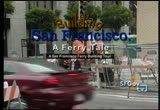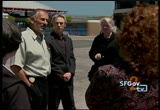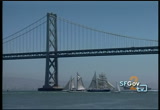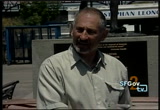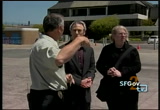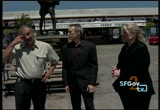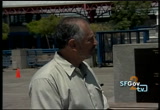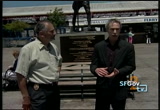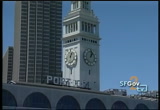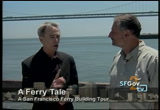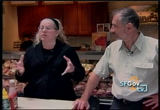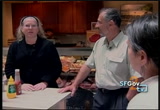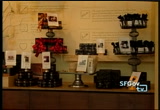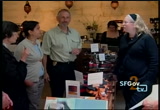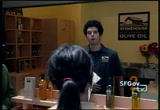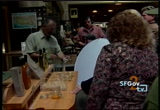tv [untitled] December 28, 2012 5:30pm-6:00pm PST
5:31 pm
chief building inspector with the department of building inspections brown bag lunch. we do this every third thursday of every month. this building behind me is one of san francisco's great landmarks, a designated landmark? >> it is on the national register list of historic buildings. >> with me i have a few guests, an old friend of mine and a partner who is a planner with the port of san francisco. welcome. thank you for coming along. and jane connors, who is the building manager. she will lead us on a walk through the building as we move along and talk about that as well. this is a fund and a unique place in san francisco, big, open space. a couple of times a week this is
5:32 pm
filled with a marketplace. >> 100 farmers. they are here on saturday. the farmers market is out front, and also on tuesday's we have about 60 farmers out front. >> and that is on the plaza? >> on saturday it is back here, and on tuesday it is in the front. >> i guess i am interested in what happens. we have a plaza where the ferry boats used to come. what happened? >> the whole backside of the building was originally line for ferryboats. it could handle about 14 boats at one time. the building was built in 1898, and the ferry boats were very popular up until the bay bridge got built in the early 1930's. at that time, the passengers shifted from taking the ferry boats out to going across the bridge and a ferry boat service
5:33 pm
diminished. >> the cars were a reduction in the use but also led to the development of the freeway in front of the ferry building, which in 1989 was damaged by the earthquake and demolished. lo and behold, we have a ferry building again after the earthquake? >> we have seen the city come around. the building was renovated and opened in 2003. at the downtown ferry terminal was expanded in 2009 perry -- in 2009. people are looking for other ways to cross the bay. they have found that the use of the ferry boats may have increased by three times it is today. >> a lot of people who are looking for alternative ways to get around, people who walk, bicycle, other transportation, less people are driving. it is not just the price of gas. >> it is fun to ride to work and
5:34 pm
along the riverfront. we see that on the weekend. the promise not it is just full of people coming down, just walking along the waterfront, ride a bike, take a walk. we're becoming one of the most public waterfronts in the country. >> once upon the time, the boats would come in here where we are standing we know that because i have a photograph of that. my wife collects historic post cards of san francisco, and we have photographs of the ferry building with all the piers in place. the ferry building went through the 1906 earthquake. how badly damaged it was it? >> just the clock tower was rendered on safe or compromised. -- it was rendered unsafe or compromised. they had thought about taking the clock tower down, but it has
5:35 pm
remained largely intact. >> we will talk more about the clock tower later on. it is beautiful. somehow or another, this big platform got built. do you know approximately when? >> in the 1970's, the park came in. they built the platform. it building and underneath this platform and across the bay. >> this was developed as part of the bart transportation strategy? >> correct, and the park construction at that time. >> it is not on this plaza, separated a little bit, let's colligate e -- let's call it gate e. >> it is adjacent. it them every now and then i talk to people who are out of
5:36 pm
town and people say where is the giant ball park. i say that it is next to pier 40. they make the assumption that it is next to pier 39, but we know that is not true. the numbering is bob and even. it -- the numbering is odd and even. then north of the ferry building we have pier one. >> 1, 3, and 5 have been redeveloped into a combination of office space and restaurants. they are in the process of leasing those out and it is also listed on the national register of historic places being a sailor, you are familiar with the public wants that sits behind us. >> usually, i sailed out of south harbor pier 40.
5:37 pm
there are very few places along the whole bay waterfront or there is public access. right up the street at pier 1 1/2 is a brand new public launch or you can pull in a boat up to 40 feet, spend hours, and it is a wonderful thing. whoever did that, thank you. >> it is a public/private partnership that was done with the port redevelopment. we hope to be putting in more of that type of facility up and down the waterfront as part of a collection of smaller facilities that may someday be used by a water taxi. >> excellent. is there any major change or vision for the plaza behind here? >> we're just starting to look at phase two of the downtown ferry terminal, looking at how we will accommodate three times as many ferry passengers.
5:38 pm
we will look at this plaza, how we best make use of it. how can a complement the ferry building and a much higher weight than it does now, and also a place where people want to be. that will be part of the upcoming study. >> we have all these various uses to make sure they're not conflicting, the use as a farmer's market and passengers, parking. i thought there were no parks or trucks allowed. what is the deal here? >> deliveries. all of the marketplace and merchants need to have vehicles to bring bread and delivered bread to other restaurants. >> that is true, we are orienting the ferry building, the first floor anyway, as part of a food center, restaurants and food services and supplies,
5:39 pm
and we need a place to deliver. you surely cannot park on embarcadero to deliver. you need a place to do it. when i tried to drive back here, they will not let me. >> there are a number of public and private parking garages within walking distance. people who visit the farmers market or ferry building can find those. some of those are on the website. >> we just heard three blasts of the ferry horn. that means? backing up, and 5 means watch out, imminent danger. look at the ferry building, it was built in 2003, just after
5:40 pm
returned 100 years old. that is the first major piece of this area. the next piece will be the continuing expansion of the downtown ferry terminal, keeping the transportation function of the ferry building authentic. it is the ferry building, outgoing on ferries. that is the primary use. also, looking at renovating the other historic structures. pier 1 has been renovated, one- and-a-half to 5 are on the historic register. to continue to take care of these historic resources, and then improve the facilities for passengers, more covered waiting areas, and also looking at the public space. when you are a visitor to the waterfront, riding the ferry are coming down to enjoy the waterfront, that public space is what you expect and enhances the visit. >> i remember something about
5:41 pm
uses on the waterfront having to be maritime related. is there a change in that direction? >> the port is a very nontraditional port. when you think of most ports, they are cargo facilities. the port of santa cisco has limited cargo, but it is very diverse. -- the port of san francisco has limited cargo, but it is very diverse, fishing industry, tugboats, ship repair, cargo, and a couple of others. as we redevelop the waterfront, we are integrating all of those individual uses into new development. you mentioned one and a half, the boat dock. we are working on a terminal facility, pier 27, always looking to integrate those in. unfortunately, those all need money, so we have to look at revenue-generating sources.
5:42 pm
>> are you limit it to maritime uses? >> there are other uses. we are state land, not city property. the state land has a lot of uses. the office has to be maritime- related, unless it is an historic building. our facilities have to be for the people of the state of california. they have to enhance that visit there. they're not local surfing. we cannot do any residential on the waterfront and we cannot do any hotels over the waterfront. there is property on the embarcadero for that. >> somebody told me there were 11 different agencies, probably more that regulate the use of the space. >> it is the city and town of santa cisco, the port, -- of san francisco, the port, the army
5:43 pm
corps of engineers, fish and game, boating and wildlife. >> every time somebody wants to do something, and has to go through all of these review agencies. >> it makes it very interesting. >> the port is really a separate administrative jurisdiction. the ferry boat we are not on the -- a theory but we are on is not regulated by them. at the port has its own authority granted by state law, state charter which says they have their own building department, they issue their own permit, planning department. it is a separate government organization. >> the primary mission as described by state land, number one, to provide for maritime commerce, navigation. no. 2, it is to protect natural resources. third, it provides facilities that attract people to the waterfront.
5:44 pm
that is what the state land commission is. the port does not share a budget with the city. they cannot collect any tax revenue. they do not have any taxing authority. the port lives and dies by the revenue it generates on the port property. >> how is the ferry building doing in terms of creating revenue? >> it has been phenomenally successful. we are fully leased. the active merchants are incredibly happy to be part of the vibrant community. >> this is one of the most see places in san francisco. anybody who comes here from out of town, you have to walk through the ferry building. >> there are a lot of visitors here. definitely a lot of locals, too, who feel strongly about the connection to the marketplace. >> you were mentioning that this is pierre -- pier 14. >> first, it was a brick water
5:45 pm
for the downtown ferry terminal, constructed in 2001. after that, we added public access on top of it and connected it to the land side. now is eight 637-foot-long public access pier to enjoy the day, watched the very activity. there is a little bit of art on top of it. there are swivel chairs on a it and there are little sea >> can you t about proposition a that may affect this waterfront parks -- that may affect the waterfront? >> of the voters approved proposition 8. >> which was how much? >> the total bond was $135
5:46 pm
million. it will improve about 6 open spaces on the waterfront. it 11 years ago, the port developed its first ever land use plan, and part of that list policy for continuous open waterfront of 7 1/2 miles of the port of san francisco waterfront and in public spaces every five-seven minute walking intervals. over the last 10, 11 years, we have been implementing that. now, proposition a, that will allow us to add about six more. >> this is part of a bay trail? >> not the sand and cisco bay trail, which goes all the way around the bay -- the sand and cisco bay trail, which goes for all the way around the bay. >>.
5:47 pm
walking trail or bicycle? >> it is both. >> ok, dan has to go. thank you very much. >> thank you, enjoy the water. >> ok, we're going to go around to the front door and look at this. the ferry building was originally built on woodpiles. that were driven down into the mud. not the bad rock. it is almost impossible to find bad rap here -- it is almost impossible to find that rocked -- bedrock. they brought this so they could build the ventilation shaft, and the construction materials were brought here. the same thing is true if you go up to camp mather. a lot of what you see at camp mather was built, part of the
5:48 pm
construction shack and places for people to lift when they build the dam. the same thing is true here. this is the bart ventilation shaft and the ferry. the average water depth isz about 40 feet, and that is about right. on this side of the bay, we have average depths better 35, 40, 50 feet. the east side of the bay is very shallow. then the larger ships that come through need to have at least 40 feet. they actually have to dredge up some of it. there is a very limited channel through the bed. in a sailboat, you cannot turn and get out of the way. next, we're going to walk across the plaza and into the ferry building. we will have over and stop at
5:49 pm
this store, and we have not all of these phenomenal mushrooms. -- and we have all of these phenomena mushrooms. >> they have an official title and placard. he is one of our tenants. ihe started out as a beat cop in san francisco, helping out at the farmers' market. he had grown up at a farm. he started getting interested in mushrooms, and it has grown into this incredible business. >> are any of these local? >> their family farm is at moth landing. they also going to the forest, and they did not tell anybody where they're going because there are very particular. you will see a forger walking
5:50 pm
through a building with a mushroom that the found after a big rainstorm and probably bring it in here. them excellent. i have never seen some of these before. the lion's mane mushroom? some of these are great. >> i love mushrooms. i am a big portobello fan. they are phenomenal. >> and the prices are the same as they are anyplace else, very reasonable. >> very reasonable, and it is going right to the grower. this is an organic meat company. since 1968, there has been no foreign cows or cattle and there. as a very pristine, beautiful meet. could i have you explain the
5:51 pm
dates? >> sure. the tag number is right on the label. that allows us to trace the steer back to its mother, it's mother's mother, how they were raised, how they lived. >> what is on sale today, what is the special day? >> >> everything is special. >> the caveman pork chop. >> fascinating. bone in. wow. >> that is something you do not see very often. the belly is attached.
5:52 pm
>> bacon and the loin, if you so desire. thank you very much. >> in 1999, we put out a rfp to restore the building. they decided to restore this in the middle of the building and opened up this cut out to connect the bottom floor with this area that was traditionally storage for luggage, trunks and supplies for the ferries. the connected the bottom floor with the skylight and really open up the building. >> is still open? >> it was still open it, and the second floor was the original waiting room. the port was very intrigued by the local business uses that would be down here. it took about four years to restore the building, and it took close to two years to lease
5:53 pm
it because we started early in the redevelopment of the building. we are fully leased. lots of wonderful partisans -- lots of wonderful artisans. >> unqualified success. >> in the 1950's, after the bridges were built, the port and the ferries stopped in the late 1950's. at the port was looking for new ways to build revenue. that is when they started to chop up the building on the second and third floor into small offices. that brought revenue, but also took away a lot of the historic elements. it was mostly restaurants beneath. then in 1972, the ferry started. in 1989, we had the earthquake that rendered the double decker freeway on safe. -- unsafe. >> in 1989, the ferry building
5:54 pm
was a symbol of the earthquake because the clock stopped and the flagpole on the top was tipped over at 10 degrees. this became a symbol of the earthquake. this is sort of the end product of finally taking care of all the damage that was brought by the earthquake. >> when the freeway was taken down, it provided this visual corridor and reconnected the city to the building and that opened up the dialogue. the original urban planning of san francisco, always wanted the ferry building to anchor bourbon st. it is amazing that the freeway up there has been changed around to see the visual connection, literally all the way up market street to the ferry building. it it feels like the heart of san francisco. >> what shop is this? >> a chocolate shop. this is one of our original
5:55 pm
farmers market food are lessons -- food artisans. he uses a lot of wonderful local ingredients, lavender, and also incredible lime that he then dips in key lime juice and then they are dried. then they are dipped into a beautiful artisan chocolate, and it to me epitomizes what it is all about, local ingredients, very traditional french techniques when it works with the chocolate. i want you guys to try it. it is super, super good. >> yes, i will take a piece here. enjoy. enjoy. take one and pass it around. san francisco has become a chocolate center. >> dear deli, they realize
5:56 pm
they're not going to make money with gold, one back to france and brought back chocolate equipment. and longtime chocolate tradition. >> i was reading house so many people came here for the6ñ and some of the smart people stay here because they said these people are going to need services, food, places to stay, entertainment. people bought land and made buildings. some people made their fortunes in the gold fields, but a lot of people who started their companies after the gold rush made it really big. some of them are still here, historic buildings, is sort restaurants -- historic restaurants, and we're trying very hard to preserve not just the physical brick and mortar of san francisco boat -- san francisco history, but there is
5:57 pm
also a real push to preserve the cultural, meaningful institutions, businesses, restaurants, other services. i encourage you all to support san francisco businesses. there are so many old restaurants. this is some serious chocolate. >> it is really good. q%?>> our groves were planted r 100 years ago. it is called the silver ridge ranch, and it is all spanish olives, extra virgin, less than 0.8% at the city. -- acidity. we offer a house plant, which is a nifty blend of five types of
5:58 pm
spanish olives, which incorporates this into that. we also offer a tangerine olive oil, a new product, fresh tangerines. you taste possessed from the appeal of the tangerine. -- you taste the zest from the peel. >> emerge very well. excellent. they sell different types of salt here which are a big thing in it killing our world. i have found at home that it makes a big difference the texture of the salt, not word is from -- where it is from. where is this from? >> it is from france, the top layer of of salt, a very fine
5:59 pm
salt. for every 80 pounds of the great salt, 1 pound of this is made. >> we did not really talk about the clock tower yet. at 230 feet tall, this is built as a replica of of the clock tower in spain. this was electrically i polite. electrically operated? >> correct, but it still can be run mechanically. ithe clock master comes in at te time that it is changing. we also have clock watchers across the street who tell us if it is off by a second, so he is very attached to the clock. >> we have a clock master. and look at this, the hands of the clock. look how big they
162 Views
IN COLLECTIONS
SFGTV2: San Francisco Government Television Television Archive
Television Archive  Television Archive News Search Service
Television Archive News Search Service 
Uploaded by TV Archive on

 Live Music Archive
Live Music Archive Librivox Free Audio
Librivox Free Audio Metropolitan Museum
Metropolitan Museum Cleveland Museum of Art
Cleveland Museum of Art Internet Arcade
Internet Arcade Console Living Room
Console Living Room Books to Borrow
Books to Borrow Open Library
Open Library TV News
TV News Understanding 9/11
Understanding 9/11
